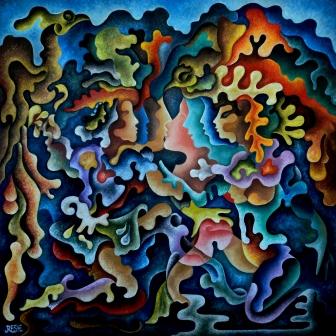ABSTRACT ART — history of development. Part 1.
–Dynamics of colours#4– oil on canvas 80x80cm.
From 1907 to 1915 artists in Russia, Western Europe and the United States began to create abstract works of art, so the researchers believe are called first by Wassily Kandinsky, Kazimir Malevich and Piet Mondrian. Still, the year of birth is considered to be non-figurative art in 1910-th, when in Germany, Murnau, Kandinsky wrote his first abstract composition. The following year, in Munich, he published a now famous book “On the Spiritual in Art”, in which thinking about the possibility of realization of inner necessity, the spiritual as opposed to the external random. The basis of the “rationale” abstractions of Kandinsky laid down theosophical and anthroposophical study of the works of Helena Blavatsky and Rudolf Steiner.
«Abstractio» means “a distraction.” Applied to art, this term allows the transfer characteristics of artistic consciousness, directed in search of harmony from the particular to the universal. Not by chance in the early decades of abstract art needed a theory of symbolism, in an address to the mystical ideas, but later artists increasingly fascinated by the problems associated with biophysical discoveries, attempts to embody the concept of time and space, infinity natural forms, hidden behind veils. One of the first abstract artists, the creator of “Rayonism” Mikhail Larionov represented the “light of the reflected light (color dust).”
Abstract art – “the most affordable and noble way to capture personal being, and in a form that may be the most appropriate – like a facsimile reprint. At the same time it is a direct realization of freedom. ”
In the 1920s, during the rapid deployment of all abstract art avant-garde directions included in its orbit Cubo-Futurists, abstractionists, Constructivists, suprematists (A. Exter and Popova, Alexander Rodchenko and Vladimir Stepanov, G.Stenberga and M. Matyushina , N. and J. Suetina Chashnik). Language of non-figurative art was the basis of a new culture, modern plastic form, easel, decorative or monumental, and had all the opportunities for further fruitful and long-term development. .
With the coming to power of the Nazis moved to the center of abstract America. In 1937 in New York, created a museum of non-objective painting, family-based millionaire Guggenheim in 1939 – Museum of Modern Art, Rockefeller created the means. During the Second World War and after it in America gathered in general, all the ultra-forces of the art world.
